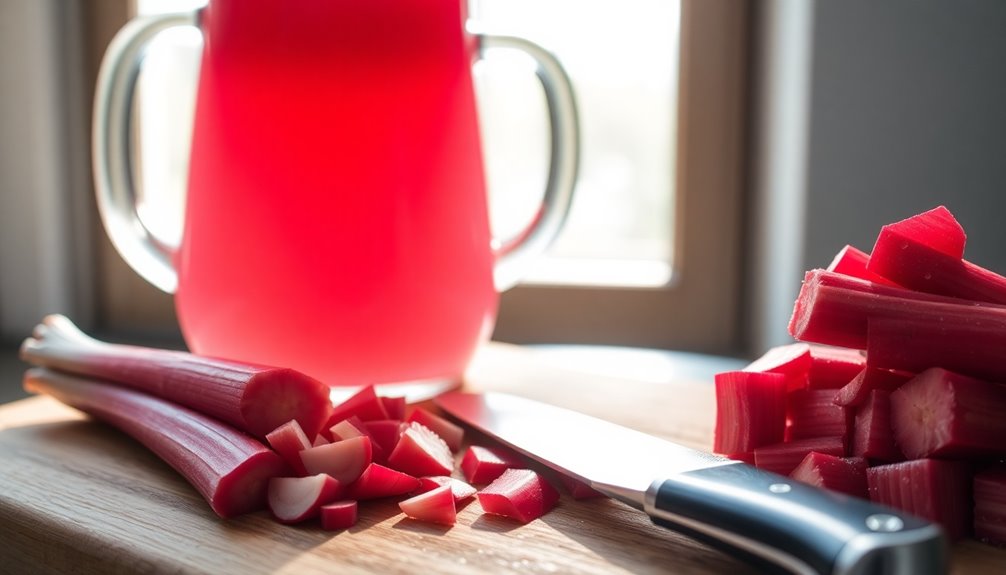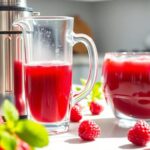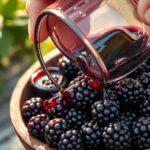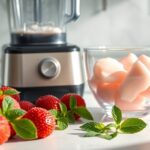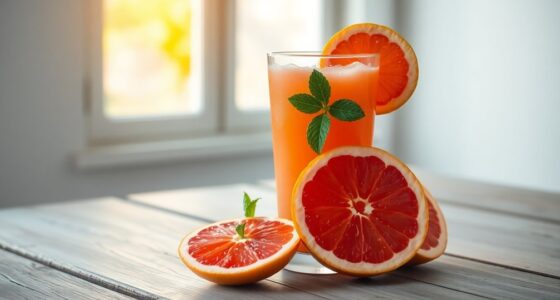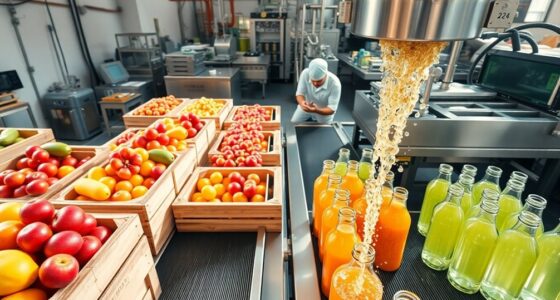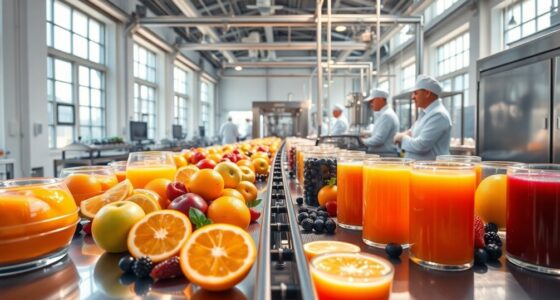To make delicious rhubarb juice at home, chop 1 pound of fresh rhubarb and simmer it in 4 cups of water for 15 minutes. Strain the mixture to extract the juice and sweeten with sugar while it's warm, if desired. Chill the juice and serve it over ice for a revitalizing drink. This tart beverage is perfect for summer days. Stick around to discover tips on storage, preservation, and more rhubarb recipes!
Key Takeaways
- Use 1 pound of fresh rhubarb stalks, chopped, and combine with 4 cups of water for optimal flavor extraction.
- Boil the mixture, then cover and simmer for 15 minutes to enhance the tart essence of the rhubarb.
- Strain the liquid using a fine-mesh strainer to separate the juice from the solids for a smooth beverage.
- Add granulated sugar while the juice is warm, adjusting sweetness to your taste preference.
- Store the fresh juice in an airtight container in the refrigerator for up to 7 days or consider canning for long-term preservation.
Why It Works
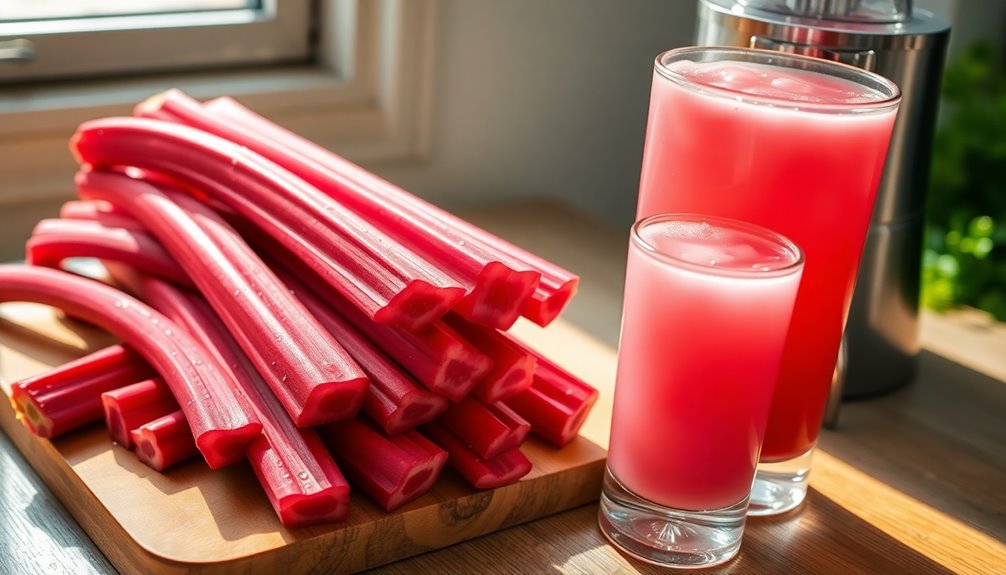
When you make rhubarb juice, you're not just enjoying a revitalizing drink; you're experiencing the natural flavors that shine through with just two simple ingredients.
The rhubarb juice recipe focuses on boiling rhubarb with water, which helps extract as much juice as possible while capturing its tart essence. This method results in a invigorating beverage that's reminiscent of homemade lemonade, perfect for hot summer days.
Plus, since you're not adding any simple syrup, you can easily adjust the sweetness to match your taste.
With rhubarb in season during late spring and early summer, it's the ideal time to whip up this delicious drink, allowing you to savor the pure, unaltered flavors of this unique ingredient.
Special Equipment
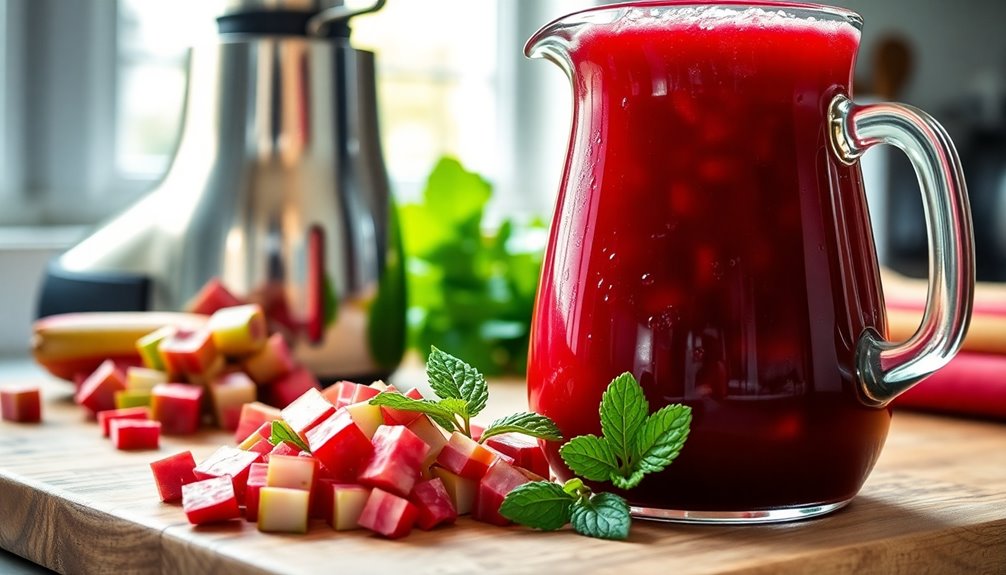
To create delicious rhubarb juice, you'll need some essential equipment to streamline the process.
Start with a 5-quart pot or a large Dutch oven; this will efficiently boil your rhubarb and water mixture to extract maximum juice.
You'll also need a fine-mesh strainer to separate the liquid from the rhubarb solids, ensuring a smooth final product. For even clearer juice, consider using cheesecloth alongside the strainer.
Once you've strained the juice, a pitcher or spouted bowl will come in handy for holding and pouring your invigorating drink.
And don't forget to keep some ice on hand for serving; it'll enhance the chilled experience, especially on warm days!
Enjoy your homemade rhubarb refreshment!
Ingredients for Rhubarb Juice
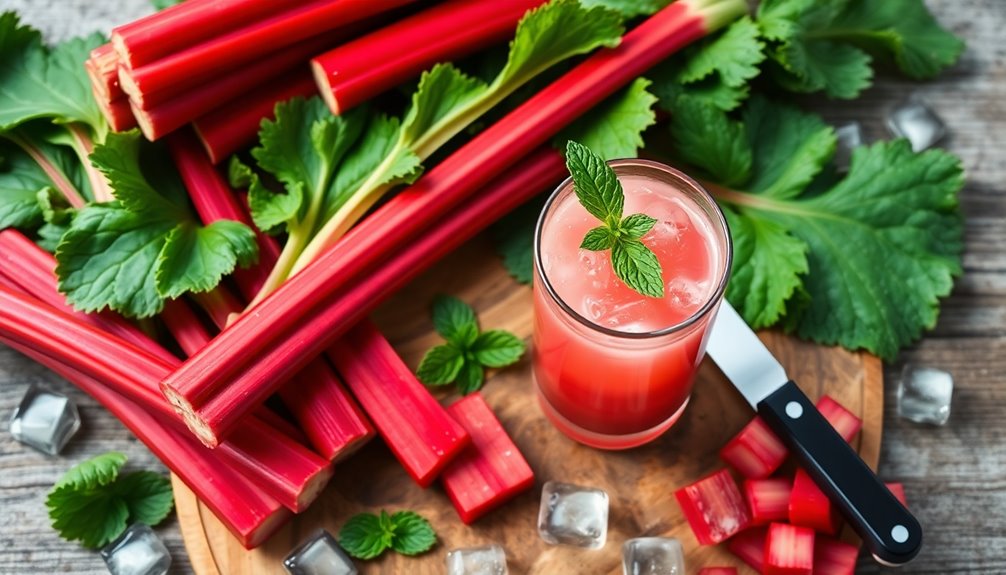
Now that you've got the necessary equipment ready, let's gather the ingredients for your rhubarb juice.
You'll need 1 pound of fresh rhubarb stalks, chopped into smaller pieces. When selecting rhubarb, look for thin, red, tender stems with shiny skin for the best flavor and color.
Remember, avoid the leaves, as they're toxic due to high oxalic acid content.
Next, measure out 4 cups of water to help extract that delicious juice. If you prefer a sweeter taste, you can add 1/4 cup of granulated sugar, but feel free to adjust this to your liking.
Fresh rhubarb is typically in season from late spring to early summer, making this the perfect time to whip up your revitalizing juice!
How to Make This Recipe
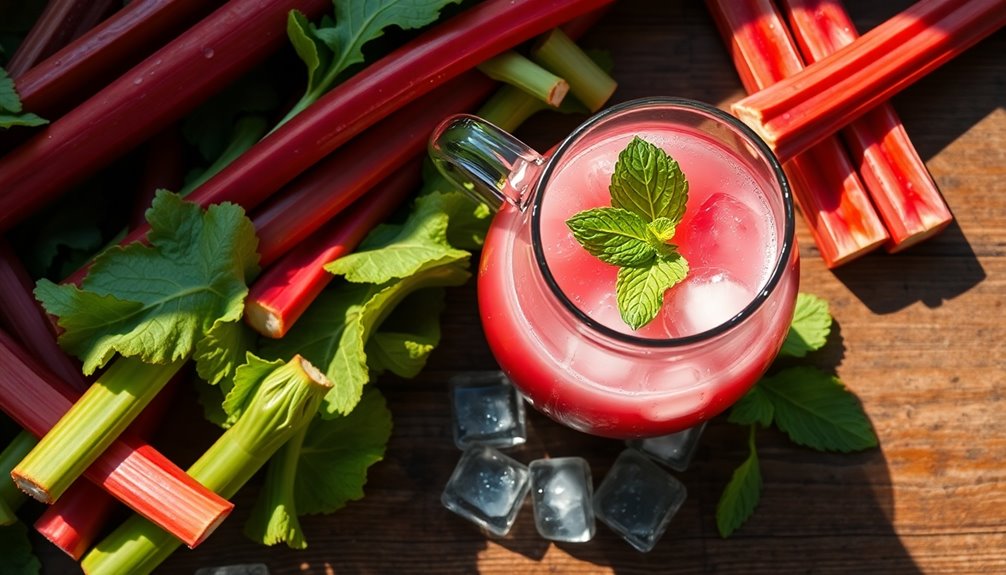
Start by washing and chopping 1 pound of fresh rhubarb into one-inch segments, then combine it with 4 cups of water in a large pot.
Bring the mixture to a boil, reduce the heat, cover, and let it simmer for 15 minutes to extract the flavors.
After that, set up a fine-mesh strainer over a medium bowl and pour the rhubarb mixture through it, pressing the solids to extract as much liquid as possible.
While the juice is still warm, stir in 1/4 cup of granulated sugar until it dissolves.
Cool the juice at room temperature before refrigerating it for several hours.
Now you're ready to enjoy your delicious rhubarb juice! Make this recipe and sip on something invigorating!
How to Serve Rhubarb Juice
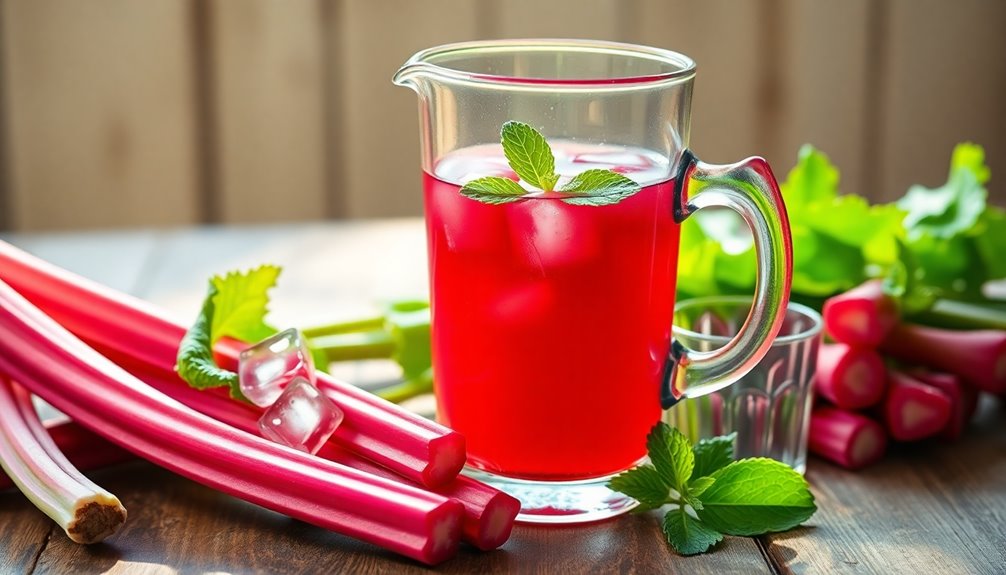
Serving rhubarb juice can elevate your refreshment game, especially when you chill it and pour it over ice for a tart, revitalizing drink reminiscent of homemade lemonade. You can also sweeten the juice to your liking, using simple syrup or other liquid sweeteners. For a milder flavor, consider diluting the juice with cold still or sparkling water in a 1:1 or 2:1 ratio.
Here's a quick guide to serving:
| Option | Description | Tip |
|---|---|---|
| Serve Cold | Chill well before serving | Use ice for extra chill |
| Sweeten the Juice | Adjust sweetness as desired | Add syrup to taste |
| Cocktail Mixer | Mix with vodka or gin | Garnish with mint leaves |
Enjoy your invigorating drink!
Storage and Preservation Tips
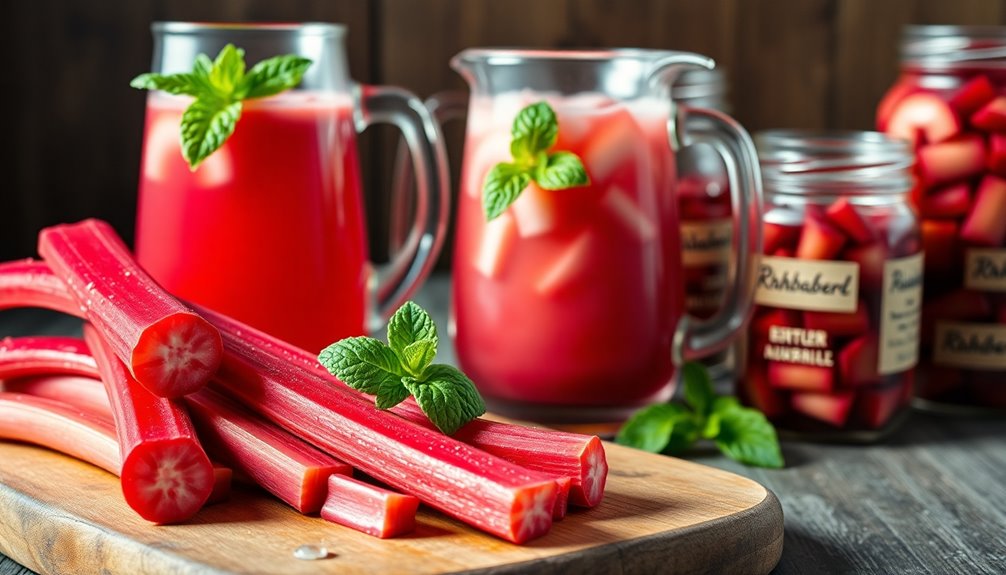
To keep your rhubarb juice fresh and flavorful, proper storage is essential. You can refrigerate fresh rhubarb juice for up to 7 days in an airtight container.
If you want to store it longer, consider canning it. When canning, make sure to process the jars in a hot water bath for the right time based on your altitude. Properly sealed canned rhubarb juice can last up to 12 months. Additionally, always ensure that your jars are sterilized before filling them with the juice to prevent any contamination. If you’re curious about other juices, you might wonder, “how long does orange juice last? ” Freshly squeezed orange juice can stay good in the refrigerator for about 2-3 days, while commercially bottled varieties may last longer depending on preservatives and packaging. Remember to label your canned jars with the date, so you can keep track of their shelf life.
If you prefer freezing, you can do so for up to 6 months. Regularly check the seals of your canned jars after cooling; any unsealed jars should be refrigerated and used within a week.
Don't forget to compost or feed leftover pulp to minimize waste!
More Recipes and Uses for Rhubarb
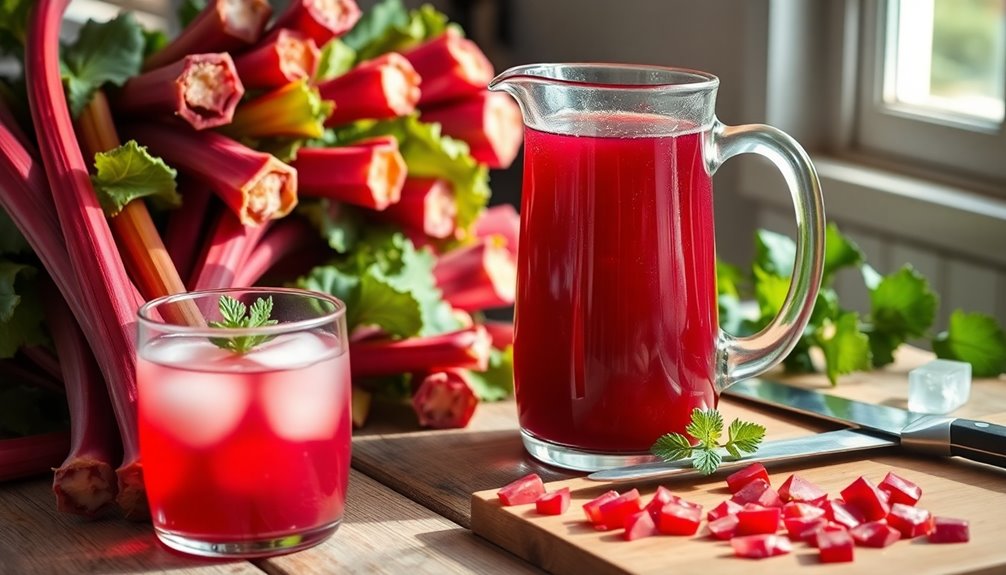
While rhubarb is often celebrated for its tartness in desserts, its culinary potential extends far beyond sweet treats. You can explore various recipes that highlight its unique flavor. Consider making rhubarb compote to serve over pancakes, yogurt, or ice cream. Mix rhubarb juice with lemonade for a revitalizing summer drink, or use it as a cocktail mixer for rhubarb margaritas. You can even incorporate rhubarb into savory dishes like sauces or marinades, adding a tangy flavor contrast.
| Dish | Main Ingredient | Flavor Profile |
|---|---|---|
| Strawberry Rhubarb Crisp | Rhubarb, Strawberries | Sweet & Tart |
| Rhubarb Coffee Cake | Rhubarb | Moist & Sweet |
| Rhubarb Compote | Rhubarb, Sugar | Sweet & Tangy |
| Rhubarb Lemonade | Rhubarb Juice | Revitalizing |
| Rhubarb Marinade | Rhubarb | Tangy & Savory |
Frequently Asked Questions
How Do You Enhance Rhubarb Flavour?
To enhance rhubarb's flavor, pair it with sweeter fruits like strawberries or apples to balance its tartness.
Adding a splash of lemon juice brightens the taste, while a pinch of salt can amplify its natural flavors.
Incorporating fresh herbs like mint or basil introduces aromatic notes that complement its tang.
For sweetness, try honey or simple syrup, and don't hesitate to experiment with spices like ginger or cinnamon for added warmth and depth.
Can Raw Rhubarb Be Juiced?
Yes, you can juice raw rhubarb, but you'll find it's extremely tart.
To make it more palatable, you might want to mix it with sweeter juices or add a sweetener.
Remember, always discard the leaves since they're toxic.
Start by chopping the stalks into small pieces, then boil or blend them before straining to extract the juice.
Enjoy the antioxidants, but keep your consumption moderate for the best health benefits.
Is Drinking Rhubarb Juice Good for You?
You might think rhubarb juice isn't good for you due to its tartness, but it's actually packed with health benefits.
Drinking rhubarb juice can boost your antioxidant intake, helping to reduce inflammation and protect your heart. It's low in calories and high in dietary fiber, promoting digestive health and weight management.
Just remember to enjoy it in moderation, as too much may lead to some health issues from oxalic acid.
What's the Best Way to Prepare Rhubarb?
To prepare rhubarb, start by trimming the ends of the stalks and discarding any leaves, as they're toxic.
Chop the stalks into one-inch segments to guarantee even cooking. Choose fresh, shiny, and tender stems, ideally red, for the best flavor.
Cook the chopped rhubarb by boiling or steaming to reduce its tartness and enhance its flavor. This simple method makes it more enjoyable in various dishes or beverages.
Enjoy your fresh rhubarb!
Conclusion
So, you've mastered the art of rhubarb juice, a drink that's surprisingly sweet despite rhubarb's reputation for being tart. Who knew that this humble, often overlooked vegetable could transform into such a revitalizing delight? Now you can impress your friends with your newfound mixology skills, all thanks to a plant that's usually relegated to pies. Enjoy sipping your homemade concoction while secretly relishing the irony that something so sour can lead to such sweet satisfaction!
Cindy thoroughly researches juicing trends, techniques, and recipes to provide readers with practical advice and inspiration. Her writing style is accessible, engaging, and designed to make complex concepts easy to understand. Cindy’s dedication to promoting the advantages of juicing shines through her work, empowering readers to make positive changes in their lives through the simple act of juicing.

